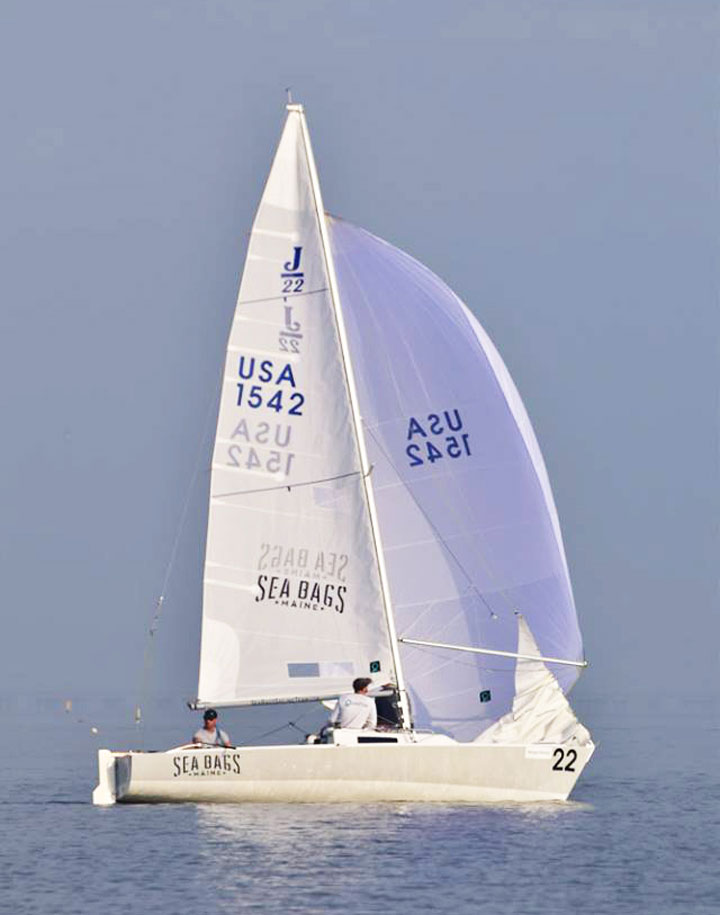Uncooperative conditions left teams on the docks to start at the 2017 J/22 Midwinter Championship, then saddled them with light shifty conditions to round out the weekend. Quantum’s Terry Flynn and Travis Odenbach detail their tips for navigating these types of situations with some good reminders.
 Photo by Chris Howell/Class Association
Photo by Chris Howell/Class Association
High winds and big gusts set the tone at the 2017 J/22 Midwinter Championship, hosted by the Southern Yacht Club in New Orleans. The southern hospitality was plentiful (I'm not sure the word moderation is in their vocabulary), but they couldn't do anything about the weather. Though we didn't get in as many races as we'd hoped, the conditions provided the perfect opportunity to practice race strategy, experiment with unique wind patterns, and test our recently-updated tuning guide.
With winds from 18-34 knots on Friday, the race committee cancelled the races after a boat capsized (and sunk!) during pre-race practice. Saturday was just as windy, with gusts up to 40 knots (and a baby waterspout trying to form right off the harbor). The race committee kept us at the dock for another day.
Sunday was the break we were looking for. The warning gun sounded earlier than originally planned so we could get in as many races as possible. When the smoke cleared, we managed to run three races in light and shifty conditions. Quantum’s Travis Odenbach and I both finished in the top five and walked away with some great reminders on the importance of your game plan, tactics, and tuning.
Game Plan
Leave the dock with a rough idea what you want to do and then fine tune your plan during the pre-start. Make sure everyone knows your high-level plan and anything else that might be helpful as far as tactics. However, don’t forget you have to be flexible and be ready to adjust your plan or throw it out the window and quickly make a new one.
Having a good game plan was key in the light and shifty winds we had on the last day, but so was flexible thinking. On our boat, we looked over the course pre-start and decided which side we wanted to get to (the left). Coming off the line with speed was important. Our plan worked for the first race, but it went out the window as the wind shifted, giving better velocity on the right (and leaving us at the back of the pack at the windward mark). We were lucky – thanks to a big right shift on the final run, were able to claw our way out and finish second.
Odenbach’s approach worked better: he started towards the middle of the line, letting him capitalize on the first shift (and giving him more flexibility to get to either side should he need to). “I wanted to stay in the pressure and on the lifted tack,” he said. That sounds simple, but with other boats using the same strategy, only a few of them could pull it off.
 Photo by Chris Howell/Class Association
Photo by Chris Howell/Class Association
Tactics
If you’re sailing in a new location, get local knowledge about wave, current, and wind patterns. Every locale has its own quirks and it’s important to know what that means for your game plan.
New Orleans is a hard place to race in light winds because the wind doesn’t act like it does on most lakes. It seems to stay in one place and not slide to leeward (as most sailors expect it to). We learned that you can't set up under the puff and let it come to you. You have to get into the puff, then decide if you want to extend or tack.
Course Adjustments
The characteristics of the course will often dictate your plan or cause adjustments to your normal trusted approach.
The midwinters featured a long starting line and short windward leg. That type of race course makes it hard to start at the leeward end and have any chance of getting back to the right and across the fleet. Without a big shift to the left, it’s better to start toward the middle and reduce the leverage on the boats to windward.
Tuning
Always make sure your rig is tuned for the conditions and talk with others in the fleet about what they’re doing and experiencing. Rising tides raise all boats. Share information and let your sailmaker know what you’re seeing, too!
While we didn’t get to race much at this regatta, Odenbach and I had the chance to work with customers on tuning and settings, and we proved that our newly-revised tuning guide is spot on.
We had found our older tuning guide had a little too much tension on the lowers, causing the middle mast (spreader area) to poke to windward in the lighter settings. We corrected this problem and now see a nice fail curve with a little sag to leeward at the spreaders. We also added another setting for the top of the wind rages to remove some of the pre-bend while keeping plenty of range on the backstay to invert the mainsail in the big puffs. The revised tuning guide worked for us in New Orleans (and it should work for you too – you’ll find it here).
At the end of the regatta, Odenbach finished in second with Matt Thompson and Kevin Kenny's Quantum spinnaker powering them to third. I rounded out the top five, while Quantum sails helped power Peter Doyle and Jack Huebschmann to a sixth-place finish.
Check out the results from the 2017 J/22 Midwinter Championship.